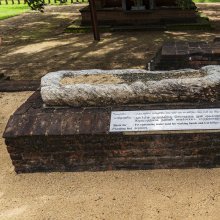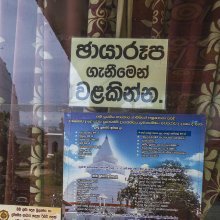Dat, Ḍaṭ: 6 definitions
Introduction:
Dat means something in Hinduism, Sanskrit, Jainism, Prakrit. If you want to know the exact meaning, history, etymology or English translation of this term then check out the descriptions on this page. Add your comment or reference to a book if you want to contribute to this summary article.
Images (photo gallery)
In Hinduism
Vyakarana (Sanskrit grammar)
Source: Wikisource: A dictionary of Sanskrit grammarḌaṭ (डट्).—tad. अ (a), affix in the sense of पूरण (pūraṇa) applied to a numeral to form an ordinal numeral; e. g. एकादशः, त्रयोदशः (ekādaśaḥ, trayodaśaḥ), cf. P.V.2.48

Vyakarana (व्याकरण, vyākaraṇa) refers to Sanskrit grammar and represents one of the six additional sciences (vedanga) to be studied along with the Vedas. Vyakarana concerns itself with the rules of Sanskrit grammar and linguistic analysis in order to establish the correct context of words and sentences.
Languages of India and abroad
Sanskrit dictionary
Source: DDSA: The practical Sanskrit-English dictionaryDat (दत्).—m. A tooth; (a word optionally substituted for danta in all the case-forms after the acc. dual. It has no forms for the first five inflections).
Source: Cologne Digital Sanskrit Dictionaries: Shabda-Sagara Sanskrit-English DictionaryDat (दत्).—m.
(-dantaḥ-dantau-dantaḥ) 2nd case plu. (dataḥ) A tooth: see danta; the nasal is dropped after the 2nd case. E. dam to subdue, affix ḍat.
Source: Cologne Digital Sanskrit Dictionaries: Monier-Williams Sanskrit-English Dictionary1) Dat (दत्):—m. (taking the form danta in the strong cases, [Pāṇini 6-1, 63]) a tooth, [Ṛg-veda] ([nominative case] dan, [x, 115, 2]), [Atharva-veda; Vājasaneyi-saṃhitā; Śatapatha-brāhmaṇa; Āśvalāyana-gṛhya-sūtra; Bhāgavata-purāṇa]
2) often ifc. ([Pāṇini 5-4, 141-145]) See aetc.
3) [a-dat-ka]
4) [dac-chada]
5) cf. ὀδόντ, [Latin] dens etc.
Source: Cologne Digital Sanskrit Dictionaries: Yates Sanskrit-English DictionaryDat (दत्):—(ntaḥ) 1. m. plu. Tooth, teeth.
Sanskrit, also spelled संस्कृतम् (saṃskṛtam), is an ancient language of India commonly seen as the grandmother of the Indo-European language family (even English!). Closely allied with Prakrit and Pali, Sanskrit is more exhaustive in both grammar and terms and has the most extensive collection of literature in the world, greatly surpassing its sister-languages Greek and Latin.
Prakrit-English dictionary
Source: DDSA: Paia-sadda-mahannavo; a comprehensive Prakrit Hindi dictionaryDaṭ (दट्) in the Prakrit language is related to the Sanskrit word: Draṣṭṛ.
Daṭ has the following synonyms: Ṭhu.
Prakrit is an ancient language closely associated with both Pali and Sanskrit. Jain literature is often composed in this language or sub-dialects, such as the Agamas and their commentaries which are written in Ardhamagadhi and Maharashtri Prakrit. The earliest extant texts can be dated to as early as the 4th century BCE although core portions might be older.
See also (Relevant definitions)
Starts with (+511): Dacchada, Dachchhada, Dadvat, Dadvati, Dantarbuda, Dat bigli, Dat bijla, Dat bijli, Dat mue, Dat-bijla, Dat-kapat, Data, Data data, Data Sutta, Databalem, Databba, Datadata, Datadatisu, Datadhamakata, Datai.
Ends with (+83): Acodat, Adadat, Adat, Ahedat, Akhidat, Akridat, Anadat, Anapavadat, Anukchindat, Anyatodat, Apannadat, Api api ludat, Apravadat, Arokadat, Asambhindat, Avadat, Avasidat, Avicchedat, Avicchindat, Ayodat.
Full-text (+731): Ubhayatodat, Udagradat, Dvidat, Caturtha, Shuddhadat, Arokadat, Avacakshe, Ayodat, Caturdat, Shyavadat, Namas, Shodasha, Trimsha, Thu, Proth, Drashtri, Vimsha, Saptadashan, Ciraratra, Paryutsuka.
Relevant text
Search found 7 books and stories containing Dat, Ḍaṭ, Daṭ, Daṭ; (plurals include: Dats, Ḍaṭs, Daṭs, Daṭs). You can also click to the full overview containing English textual excerpts. Below are direct links for the most relevant articles:
Manusmriti with the Commentary of Medhatithi (by Ganganatha Jha)
Verse 2.38 < [Section XIII - Initiation (upanayana)]
Verse 1.43 < [Section XXV - The Viviparous, Oviparous, Sweat-born and Vegetable Beings]
Verse 7.136 < [Section XI - Customs-Duties]
Rig Veda (translation and commentary) (by H. H. Wilson)
The Linga Purana (by J. L. Shastri)
Chapter 6 - The origin and activities of Alakṣmī < [Section 2 - Pūrvabhāga]
The Mahavastu (great story) (by J. J. Jones)
Chapter XLI - The temptation by Māra < [Volume III]
Chapter XXXII - The five monks < [Volume III]
Chapter XIV - The great renunciation < [Volume II]
Saraswati < [Aug - Sept 1939]
Kathasaritsagara (the Ocean of Story) (by Somadeva)
Chapter LXXIII < [Book XII - Śaśāṅkavatī]

